Terrible Beauty
Patricia Briggs did the Trialogue for the MAEP exhibition I Will Follow You into the Dark: Paintings by Megan Rye; and War Mediated: Work by Camille Gage, Justin Newhall, and Megan Vossler. The show is up through October 28.

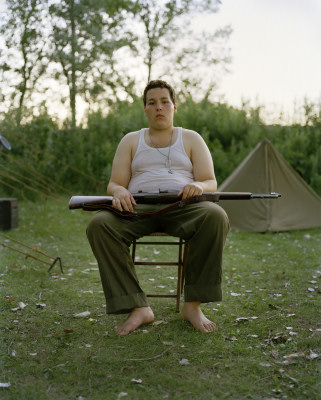
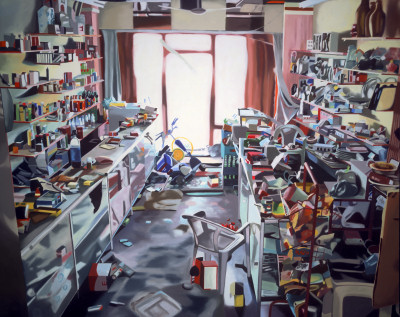
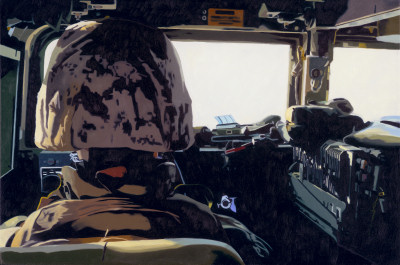

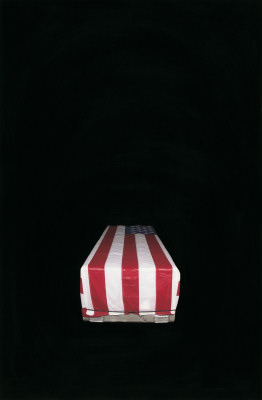
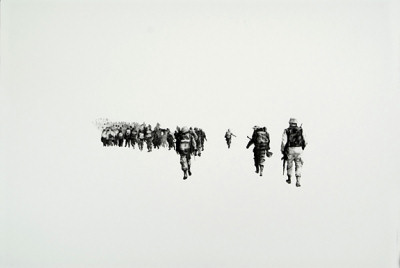
Trialogues are discussions among three sorts of participants: a critic, an artist or artists, and an audience. They are produced by the Visual Arts Critics Union of Minnesota (VACUM) at the Minneapolis Institute of Arts for their Minnesota Artists Exhibition Series. They are often attended by 50 people or more and have produced lively discussion of the work on show. This is an edited version of Patricia Briggs’ Trialogue this month in the current MAEP show.
The creative act (of viewing)
Every viewer is a critic. When standing before a work of art every viewer makes value judgments, analyzes, and interprets. Critics differ from the average viewer only in that they spend most of their time thinking about art and they muster the gumption to write about it.
When a work of art is presented to the public its axis of meaning shifts from the artist to the viewer. The viewer reads, deciphers, or re-writes the meaning of the artwork; the artist’s intention is overwritten by the viewer’s attention. In some sense the work is recreated by the viewer’s work of perception and assimilation, of the need to make his or her own sense of it. This means that there are many shows on view here, each one belonging to a different spectator. The one I’ll talk about is mine; you will each have your own.
In a forum like the Trialogue—where critics, artists, and audience come together in conversation—there can be a struggle over meaning. It is a place where conflicting views may be voiced.
The Exhibitions
I’ll get my own judgment out of the way. I very much like all of the work exhibited in War Mediated and in I Will Follow You Into the Darkness. I think it is strong and intelligent work that demands that I think about it; it doesn’t leave me with answers. This is art’s highest calling.
The basic question I ask in response to this work: Why work like this responding to war at this time?
When we look at artists’ representations of war themes across history, we find a spectrum of approaches, which range from idealizing propagandistic glorification on one extreme and explicit protest on the other. Why avoid the representation of violence in order to suggest the reality of violence?(1) Although violence, fear, loss, and death are referred to implicitly in works by Megan Vossler, Justin Newhall, and Megan Rye, the viewer finds little explicit reference to the trauma of war or political protest here.
Gage’s War Redacted series articulates an explicit protest of censorship, yet overall this series offers contemplative images—honorific presentation of death as sacrifice. (These are descriptions of the works featured here, as they appear to me. I am not saying that these attributes are bad, merely that they are there.) It is noteworthy that all of these artists offer calm, contemplative, aesthetically pleasing imagery. In some cases, one might argue that the artists idealize their subjects. Why such beauty in conjunction with such a painful subject?
This led me to consider if the seeming ambivalence that characterizes so much of the work on view might mirror in some way my own ambivalent attitude about the current war, my own maddening confusion and inability to truly take a position of support or protest of the wars in Iraq and Afghanistan. (2)
As I thought about these issues I read various authors on the topic of war and our response to it. Jean Baudrillard, Alphonso Lingis, and Sharon Sliwinski have written about human responses to horrors and the psychological responses of Americans to 9/11 and the wars in Afghanistan and Iraq.(3) What have been our emotional responses to suicide attacks, or war as revenge for the attacks of 9/11, images of American soldiers torturing imprisoned detainees, journalists beheaded by terrorists, the American government’s justification of torture, and their attempts to hide it?
The writings of Baudrillard, Lingis and Sliwinski on this topic resonate for me. My anxiety about the war as well as my ambivalence, my apparent inability to know what to think, or what to hope for, is shared by many Americans, according to a September 2007 New York Times article on war polls. (4)
“The Psychological Register of the Abject”
According to Sliwinski and Lingis, terrorism and war can inspire abjection—a horror at facing a desired and feared thing outside of our humanity. Such things push at the limits of what we can accept about humanity, because of the way that they speak of “loss of humanity”. These are cruelties that push “up against our limits” (Sliwinski). Experiences of violence and death—particularly those perpetrated in our names–are in a category of “difficult knowledge” that is “ unthinkable”. In the face of these things we feel the impulse to turn away; we develop strategies to screen ourselves from them, to produce a “defensive screen” (Lingis).
This seems true to me. I wonder if this psychological operation of covering over, or looking away, or repackaging the horror isn’t an aspect of the mediation in opperation in much of the work on view in “War Mediated” and “I Will Follow You Into the Dark.” Perhaps the exhibitions are not only about photography’s mediation of reality (as the MAEP panel suggests) but represent an attempt to mediate, defer, or disguise death itself.
Camille Gage, War Redacted
Camille Gage’s War Redacted manipulates digital photographs produced by the military that were not intended to be seen by the public—images made available only through the mobilization of the Freedom of Information Act. She protests the censorship of images that represent the ultimate cost of war—the deaths of many men and women. Yet this series also represents a kind of psychological mediation of the fear and grief of war.
There is a reverence in this work. By covering all the visual “noise” surrounding the flag-draped caskets that appeared in the original photographs with her own black redactions, Gage presents powerfully focused iconic images. She re-presents the patriotic ritual of the honoring of the dead who have given their lives for their country. As well as protesting censorship, this series is an expression of honor for its subject.
The funeral is a way of ritualizing death, a way of wrapping the corpse in ritual to deflect its horror, or to give the death a context that makes it significant, ties it to ongoing human concerns. This ritual is a way of packaging death as an object of contemplation. Whatever the purpose of the secret military photographs of ranked flag-draped coffins, Gage’s series, which erases the quotidian documented setting of the coffins, extends the ritual focus on the coffin. War Redacted focuses on death but shows its reverent face, not its abject one.
Megan Vossler, Reconnaissance
Vossler’s beautiful drawings based on digital photographs she downloads from the U.S. Army website (army.mil) initiated thoughts about the way that an image can simultaneously represent contradictory ideas, and about how this seeming ambivalence might be productive.
The photographs Vossler works from were produced and packaged by the military for public consumption. Though not obviously propagandistic, they strategically avoid representing the horror, fear, or sorrow of war. They sanitize and idealize the war for public consumption. They are photographs that are based in reality but represent moments and angles that have been picked and chosen for the public to consume.
Vossler focuses on the way that these photos represent the moments in between violence, the moments before or after it. Here the soldier on guard waiting is a kind of metaphor for us back home waiting—for new events or turning points, for a solution. In so many of her drawings there is no way to distinguish between the soldiers or civilians. In her artist’s talk she likened this ambiguity to the strangeness of our current situation. In the post-9/11 world every civilian could be a potential terrorist. Since Abu Ghraib every soldier could be a potential torturer.
Do Vossler’s images look away from the painful truth as the digital images she works from do? Do they avoid the psychological dilemma, like our own psychic screens which protect us from our disappointment and disillusionment? Or does her aesthetic response re-package this deflection/repression, and thereby call it to our attention? Are the great areas of white ground in her drawings space that Vossler leaves “empty” for the viewer to imagine the horrors of war that inhabit a space nearly outside of the representable?
Megan Rye, I Will Follow You Into the Dark
Rye’s paintings in I Will Follow You into the Dark are interesting and rich. These large and colorful works are based on digital images taken by her brother Ryan, a US Marine who was recently in Iraq. It is fundamental to the meaning of these paintings that they are based on digital photographs shot by the artist’s brother while deployed in a war zone.
Photographs taken by American soldiers in a war zone differ from photographs constituting coverage of the war by military media. Soldiers take photographs as a record of their experience to share with family and friends. Censorship dictates to some extent their nature. Restricted from photographing sensitive subjects, soldiers’ cameras capture the people, places, and things experienced outside of combat or otherwise restricted areas. Digital photographs shot by soldiers show everyday experiences, and are passed on to friends and family.
In the age of digital photography we all shoot photographs of our travels—especially of foreign lands –to share with our inner circle. It is this quality of Ryan’s photographs that I respond to. They remind me of so many photographs that I have seen from soldiers returning from this war. Photographs of the sun setting over the military complex or a self-portrait shot in the side mirror of an armored vehicle. This characteristic of the banal, the ordinary, the everyday—this is the poignant and powerful aspect of these images, that were taken by an American soldier standing on the ground in Iraq, taken to share with his family, his inner circle. Their familiarity does not diminish their powerful impact.
The issue of the potential loss of a family member, a sister’s concern for the welfare of her brother also comes into play in these works. The death of a family member rests squarely in the category of the unthinkable, the un-representable, the abject. It seems possible that this sort of anxiety, this fear and dread, might be nearly impossible to represent. If we do indeed have psychological mechanisms that repress the unthinkable, the potential loss of a sibling would be one of the fears or anxieties one would need to protect oneself from.
Obviously Rye’s paintings shares her brother’s experiences with the broader public. They honor his bravery and his sacrifice. They suggest the artist’s empathy with her brother. Yet, as the title of this show suggests, as Rye constructs her paintings she “follows” her brother “into the dark” over and over. With each work she approaches her brother, the darkness, the fear. Yet the colorful palette, the moments of kaleidoscopic abstraction, belie this anxiety. Might this beauty serve to cover over this horror?
Justin Newhall Axis & Allies
In this talk I have attempted to engage with the notion of one kind of personal and cultural psychic response to war: the attempt to paper over anxiety and the unthinkable with imagery that turns its gaze on war’s interstitial moments, and averts its eyes from violence. Newhall’s Axis & Allies series is particularly interesting in light of these issues. Here, we see one of the cultural sites where war is made to seem familiar, acceptable, pleasurable.
Here men and boys play out sanitized and heroic versions of World War II in the fields and parks and suburbs of America for entertainment and for the pleasure to be taken in fraternity. Newhall represents one of the cultural mechanisms that covers over or deflects the horror of war. This activity of physically enacting an idealized version of war seems to be one of the ways in which we screen out war’s reality.
Interfacing with the heroic narratives of classic Hollywood film and the constructed narratives that grade school history books propound, which often sanitize and masculinize war, armed combat is cast as a story, and as an activity that we can embrace instead of reject.
Notes
1. Susan Sontag delves into this issue, which often arises in discussions about images that relate to war. Susan Sontag, Regarding the Pain of Others (New York, Penguin, 2004).
2. Ambivalence: 1. simultaneous and contradictory attitudes or feelings (as attraction and repulsion) toward an object, person, or action. (Merriam Webster online dictionary)
3. See Alphonso Lingis, “The Effects of the Picture”; Jean Baudrillard, “War Porn”; and Sharon Sliwinski, “Camera War, Again,” in Journal of Visual Culture 5 (1): 83-92.
4. Steven Lee Myers and Megan Thee, “Military Seen As Best Able to Guide War,” New York Times (Sept 10, 2007), A1, A11.